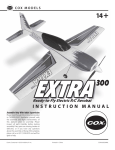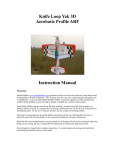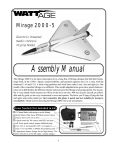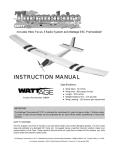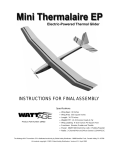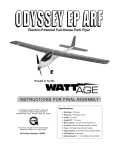Download INSTRUCTION MANUAL
Transcript
COX MODELS 14 + INSTRUC TION MANUAL Assemble Only With Adult Supervision Please read through this instruction booklet to THOROUGHLY familiarize yourself with the assembly and flight characteristics of this airplane prior to assembly. Please inspect all parts carefully before starting assembly! If any parts are missing, broken or defective, or if you have any questions about the assembly or flying of this airplane, please call us at (217) 398-8970 and we’ll be glad to help. Entire Contents ©2011 Hobbico® Inc. Printed in China COXA6503MNL 2 SKY CRUISER FCC Requirement This device complies with part 15 of the FCC rules. Operation is subject to the following two conditions. (1) This device may not cause harmful interference. (2) This device must accept any interference received, including interference that may cause undesired operation. NOTE: THE MANUFACTURER IS NOT RESPONSIBLE FOR ANY RADIO OR TV INTERFERENCE CAUSED BY UNAUTHORIZED MODIFICATIONS TO THIS EQUIPMENT. SUCH MODIFICATIONS COULD VOID THE USER’S AUTHORITY TO OPERATE THE EQUIPMENT. Precautions Your Sky Cruiser should not be considered a toy, but rather a sophisticated, working model that functions very much like a fullsize airplane. Because of its performance capabilities, the Sky Cruiser, if not assembled and operated correctly, could possibly cause injury to yourself or spectators and damage to property. 1. Operate the plane according to these instructions. DO NOT alter or modify the model. If you make any modifications, you void your warranty. 2. Test the operation of the model before each flight to ensure that all equipment is operating properly and that the model remains structurally sound. 3. Fly on calm days (with wind speeds less than 5mph) and in large open areas free of trees, people, buildings, or any other obstacles. 4. If you are in need of assistance from an experienced pilot, we suggest contacting your local R/C flying club. If you’re not a member of an R/C club, your local hobby shop has information about clubs in your area whose membership includes experienced pilots. You can also contact the National Academy of Model Aeronautics (AMA) which has over 2,500 chartered clubs across the country. Instructor training programs and insured newcomer training are available through any of these clubs. Contact the AMA at the following address or toll-free phone number: www.modelaircraft.org Academy of Model Aeronautics 5151 East Memorial Drive Ph. (800) 435-9262 Muncie, IN 47302-9252 Fax (765) 741-0057 COX MODELS 3 Thank you for choosing the Cox Sky Cruiser — and for giving us this opportunity to show you how enjoyable and rewarding R/C aviation can be. Your chances for success are excellent if you take your time and follow the instructions carefully. Before long, you’ll be ready to master higher levels of R/C flight…and the Sky Cruiser will remain a favorite even as your experience grows. Glossary Mode 2 Shown ❍ Lithium Polymer (LiPo) Battery: Rechargeable battery which is used to power the airplane. LiPo batteries are lighter and smaller than most other types of rechargeable batteries. ❍ Transmitter (TX): This is the hand-held unit that sends the signal to the control unit, or RX. ❍ Rudder: Controls yaw (turning). Antenna On/Off Switch Elevator Trim Elevator/ Rudder Control Stick Throttle Control Stick ❍ Elevator: Controls pitch (up & down). Rudder Trim Install The Transmitter Batteries Remove the battery compartment cover from the back of the transmitter. Install four fresh AA batteries according to the “+” and “–” polarity markings imprinted into the battery compartment. Replace the cover. Battery Level Icon Turn on the power switch on the transmitter and observe the battery icon in the status display. When the battery icon is blinking, the batteries are too low and should be replaced. Four squares inside the battery icon indicate that the batteries are at full power. Also note the flying mode in the status display and make sure your transmitter is configured in the desired mode. Mode 2 is most commonly used in the U.S. Flying Mode 4 SKY CRUISER Transmitter Cautions ● Do not use rechargeable (NiCd) batteries. ● Do not mix old and new batteries. ● Do not mix alkaline, standard (carbon-zinc) or rechargeable (NiCd) batteries. Charging the On Board LiPo Battery From AC Adapter Connect the AC adapter to the charger. Plug the adapter into a 110V AC wall outlet. The red power LED will illuminate. Plug the white balance connector on the battery into the port on the charger. When connected, the charger will automatically begin to charge and the green charge LED will illuminate. A fully depleted battery may take as long as 1 hour to charge completely. Partially discharged batteries will take less time to charge. The charger will terminate charge when the battery has reached its capacity. The green charge LED will go off when this happens. You can now disconnect the battery from the charger as it is ready for flight. After each flight, remove the battery from the airplane and allow it to cool before recharging. IMPORTANT! NEVER LEAVE A CHARGING BATTERY UNATTENDED! WARNING!! Failure to follow all instructions could cause permanent damage to the battery and its surroundings, and cause bodily harm! ● ONLY use the included charger to charge the LiPo battery. ● ALWAYS charge in a fireproof location. ● NEVER allow battery temperature to exceed 150°F [65°C]. ● NEVER disassemble or modify pack wiring in any way or puncture cells. ● NEVER place on combustible materials or leave unattended during charge or discharge. ● DO NOT leave the battery connected to the Sky Cruiser for an extended period of time. This can cause permanent damage to the battery. ● ALWAYS KEEP OUT OF REACH OF CHILDREN. ● DO NOT leave the battery unattended while charging. COX MODELS Battery Charging Precautions 1. Always remove the battery from your Sky Cruiser before charging. 2. Do not leave a charging battery unattended! Unplug the battery if it gets warm, even if the green charge LED has not gone out. 3. Do not use a different charger to charge the Sky Cruiser flying battery. WARNING: Misuse or malfunction may overheat the battery and charger, resulting in personal injury or damage to surroundings. Battery Recycling ATTENTION: The product you have purchased is powered by a rechargeable battery. At the end of the battery’s useful life, under various state and local laws, it may be illegal to dispose of this battery into the municipal waste system. Check with your local solid waste officials for details in your area for recycling options or proper disposal. WARNING: This product contains a chemical known to the State of California to cause cancer. 5 6 SKY CRUISER Assembling the Sky Cruiser Insert the carbon rod into the hole of one of the wing panels, making sure it is fully seated. Insert the wing into the fuselage. Fit the other wing panel onto the carbon rod. Push the wing panels together. Press the propeller onto the propeller base attached to the motor shaft. Press firmly until it clicks into place. If the propeller does not easily snap into place, rotate the propeller slightly to align the splines on the base. COX MODELS Reconfigure the Mode of the Transmitter Unless you are flying in a country where Mode 1 is prevalent, there is no reason to change the mode. If you have decided to operate your airplane in Mode 1, perform the following procedure to reconfigure the transmitter. Use a #1 Phillips screwdriver to loosen the (2) antenna mounting screws. Rotate the antenna upward until it is vertical. Rotate the antenna 180°, allowing it to be folded down the other way. Fold the antenna back down into the other side. Reinstall and tighten the (2) mounting screws. Now your transmitter has been reconfigured to operate in Mode 1 and you will be holding the transmitter 180° (seemingly upside down) from when it was set up in Mode 2. The control sticks will operate the airplane accordingly. The rest of the instructions illustrate the transmitter configured in Mode 2. 7 8 SKY CRUISER Set Up the Transmitter With the power switch on the transmitter turned on, press the trim buttons as necessary to center the trim indicators in the status display. Elevator Trim Indicator Rudder Trim Indicator Select the desired skill mode by pressing inward onto the elevator/rudder control stick. If this is your first time flying the Sky Cruiser, select the Low Rate mode. This will provide reduced control throws to lessen the chance of over-control for your first flights. As you become proficient flying the Sky Cruiser, experiment with the high rate setting at a safe altitude. Skill Mode Indicator High Rate Low Rate Be certain the transmitter antenna is in its vertical position and that the power switch on the transmitter has been turned on. Note: Unless performing the “Binding” procedure described on page 9, never allow the battery to be connected to the Sky Cruiser without the transmitter turned on. This means you should always turn on the transmitter first before installing the battery into the model, and always turn off the transmitter first before removing the battery from the Sky Cruiser. COX MODELS Also be certain the throttle control stick is fully down so the propeller will not rotate when you connect the battery. Note: If you inadvertently connect the battery with the transmitter off, or with the transmitter on but the throttle stick not all the way down, the propeller should not turn until you turn on the transmitter or move the throttle stick all the way down. Bind The Airplane To The Transmitter When the receiver is able to read signals from the transmitter, the two are said to be “bound.” Until the receiver in the airplane is programmed to read the transmitter’s signals, the airplane cannot be controlled. Your Sky Cruiser’s receiver has already been bound to its transmitter at the factory. If you ever need to re-bind them, simply follow the procedure described below: 1. Disconnect the LiPo battery from the airplane. 2. Turn on the transmitter. Lower the throttle control stick all the way down. Adjust the throttle trim tab until the throttle trim indicator is centered and the throttle position indicator reads “000.” 3. Turn off the transmitter. 4. Connect the LiPo battery to the airplane. Turn on the transmitter while pressing inward on the throttle control stick until you hear the servos activate. If you have the wing off, you will also see the red LED on the receiver illuminate. This indicates that the receiver is reading signals from the transmitter—this should happen within a few seconds. If it doesn’t work the first time, disconnect the LiPo battery from the airplane and turn off the transmitter. Repeat the binding procedure again by reconnecting the LiPo battery and turning on the transmitter with the throttle stick depressed. The receiver is now “bound” to the transmitter and the plane is ready to fly. 9 10 SKY CRUISER First Flight Turn the transmitter power switch to the ON position. Remove the canopy hatch from the fuselage by lifting it upward. Connect the battery to the plane and insert the battery into the slot at the front of the fuselage. Be sure the battery wires do not contact the servo gears in the fuselage. The motor is now considered live. Keep clear of the propeller in case of accidental start-up. Replace the canopy hatch back onto the fuselage. COX MODELS Check the Control Directions Test the control surfaces to become familiar with their operation. Point the propeller away from you when doing this in case of accidental start-up. When the right control stick is moved down, the elevator will move up. When the right control stick is moved to the left, the rudder will move to the left. When the left control stick is in the down position, the propeller will not rotate. To test the operation of the motor, be sure to have a firm grasp of the airplane with your hands clear of the rotational arc of the propeller. Be sure to point the propeller away from people or obstructions. 11 12 SKY CRUISER Adjusting the Control Trims Elevator Trim Rudder Trim 1. Before making your first flight, use the trim buttons to center the elevator and rudder surfaces. Adjust the trim as necessary using the trim buttons until the control surfaces are inline as shown. 2. If additional trim is required beyond what the trim buttons are capable of making, the clevises can be disconnected from the control horns and threaded forward or aft on the pushrods. This will allow the control surfaces to be centered with the trim buttons at or near the center position. Do not make your first flight with any of the trim buttons set at their maximum position. Mechanically trim the control surfaces as necessary if this is the case. COX MODELS Choose a Good Flying Site The Sky Cruiser should be flown outside only when the wind speed is 5 mph [8km/h] or less. If flown in stronger winds, the plane may be very difficult to control or may be blown downwind and not have enough power to get back. If the wind is calm or very light, the Sky Cruiser will be responsive and precise. Also, find an area clear of trees, power lines and other structures. A flying field for R/C planes is best. Don’t fly around groups of people, especially children. Flying indoors, such as in a gymnasium, is possible but only recommended for pilots with sufficient experience with the Sky Cruiser. Flight Although the Sky Cruiser is small, it will provide the same level of control and thus require the same amount of skill as a comparable larger R/C model. Because of this, typical launch, flight, and landing routines for larger models should also be practiced with the Sky Cruiser. Hand Launch When ready, grasp the Sky Cruiser by the fuselage beneath the wing and hold it well clear of your face and body. Move the throttle stick to full throttle. Always toss the Sky Cruiser directly into the wind. Launching into the wind will reduce relative ground speed and therefore the effort it takes to get the plane airborne. Give the Sky Cruiser a toss into the wind at a 15–20° upward angle. As soon as the plane is in the air get your fingers on the control sticks and be ready to make rudder and elevator corrections to keep the plane flying straight while gradually gaining altitude. Be smooth on the elevator stick, allowing the model to establish a gentle climb to a safe altitude before making the first turn (away from yourself ). Do not “yank” back the elevator stick forcing the plane into too steep of a climb. This could cause the model to quit flying and stall. Trimming the Sky Cruiser As soon as you have reached altitude, be prepared to trim the model for straight and level flight. A plane that is not properly trimmed will be difficult to fly at best and could also result in a crash. Level the plane with the elevator stick and slowly release the elevator stick toward the neutral position. If the Sky Cruiser pitches upward, use the elevator stick to regain control and add a few “clicks” of down elevator trim (pressing on the “up” side of the elevator trim button). If the Sky Cruiser pitches down, regain control and add a few clicks of up elevator (pressing on the “down” side of the elevator trim button). Continue doing this until the Sky Cruiser can be put into 13 14 SKY CRUISER level flight and it can maintain level flight with the elevator stick in the neutral position. Add left or right rudder trim in the same manner you did with the elevator to correct any tendency for the plane to deviate from straight flight. Flight Take it easy with the Sky Cruiser for the first few flights, gradually getting acquainted with it as you gain confidence. Adjust the trims to maintain straight and level flight. After flying around for a while, and while still at a safe altitude with plenty remaining battery charge, practice slow flight and execute practice landing approaches by reducing the throttle to see how the model handles at slower speeds. Add power to see how it climbs as well. Mind your battery charge, but use this first flight to become familiar with your model before landing. Typical flight time will be approximately 8 to 9 minutes. Landing To initiate a landing approach, lower the throttle while on the downwind leg. Allow the nose of the model to pitch downward slightly as you begin to gradually bleed off altitude. Continue to lose altitude, but maintain airspeed by keeping the nose Downwind Leg down as you turn onto the base leg. Make your final turn toward the landing site (into the wind) keeping the nose down to maintain airspeed and control. Level the attitude when the model reaches the landing site threshold, modulating the throttle as necessary to maintain your glide path and airspeed. If you are going to overshoot, smoothly advance the throttle (always ready on the right rudder to counteract torque) and climb out to make another attempt. When you’re ready to make your landing and the model is about a foot WIND or so off the ground, smoothly increase up elevator until it gently touches down. Base Leg Final Approach CAUTION If, during a rough landing, the propeller on the Sky Cruiser should become jammed and cannot rotate with the throttle in the run position, the battery and airplane electronics could become damaged. Immediately lower the throttle to stop the motor. COX MODELS 15 After the Flight Disconnect and remove the battery from the airplane. Then, switch the transmitter off. Allow the battery to cool before recharging. Check the airplane over to make sure nothing has come loose or may be damaged. Repairs Even the best R/C pilots in the world damage their airplanes every now and then. In the unfortunate event that you damage your airplane, repairs are fairly simple to make yourself. If there are any cracks in the wing or fuselage, apply 6-minute epoxy, or CA glue to the broken areas and hold them together with clear packaging tape. Let the glue harden, then carefully remove the tape. Replacement Parts List Replacement parts for the Sky Cruiser are available using the order numbers in the Replacement Parts List that follows. The fastest, most economical service can be provided by your hobby dealer or mail-order company. To locate a hobby dealer, visit the Hobbico web site at www. hobbico.com. Choose “Where to Buy” at the bottom of the menu on the left side of the page. Follow the instructions provided on the page to locate a U.S., Canadian or International dealer. Replacement Parts List Stock No. COX A 5 8 7 5 COX A 5 8 7 6 COX A 5 8 7 7 COX A 5 8 7 8 COX A 5 8 7 9 COX A 5 8 8 0 COX A 5 8 8 1 Parts may also be ordered directly from Hobby Services by calling (217) 398-0007, or fax at (217) 398-7721, but full retail prices and shipping and handling charges will apply. Illinois and Nevada residents will also be charged sales tax. If ordering via fax, include a Visa® or MasterCard® number and expiration date for payment. Mail parts orders and payments by personal check to: Hobby Services 3002 N. Apollo Drive, Suite 1 Champaign, IL 61822 Be certain to specify the order number exactly as listed in the Replacement Parts List. Payment by credit card or personal check only; no C.O.D. If additional assistance is required for any reason, contact Product Support by telephone at (217) 398-8970, or by e-mail at [email protected]. Description Hardware Set Sky Cruiser EP Motor Sky Cruiser EP Prop/spinner Sky Cruiser EP Tail Set Sky Cruiser EP Fuselage Sky Cruiser EP Canopy Sky Cruiser EP Wing Set Sky Cruiser EP 16 SKY CRUISER Warranty Hobbico® Inc. guarantees this kit to be free from defects in both material and workmanship at the date of purchase. This warranty does not cover any component parts damaged by use or modification. In no case shall Hobbico’s liability exceed the original cost of the purchased kit. Further, Hobbico, Inc. reserves the right to change or modify this warranty without notice. In that Hobbico, Inc. has no control over the final assembly or material used for final assembly, no liability shall be assumed nor accepted for any damage resulting from the use by the user of the final user-assembled product. By the act of using the user-assembled product, the user accepts all resulting liability. If the buyer is not prepared to accept the liability associated with the use of this product, the buyer is advised to return this kit immediately in new and unused condition to the place of purchase. To make a warranty claim send the defective part or item to Hobby Services at the address below: Hobby Services 3002 N. Apollo Dr. Suite 1 Champaign IL 61822 USA Include a letter stating your name, return shipping address, as much contact information as possible (daytime telephone number, fax number, e-mail address), a detailed description of the problem and a photocopy of the purchase receipt. Upon receipt of the package, the problem will be evaluated as quickly as possible. Troubleshooting PROBLEM The transmitter does not turn on when the switch is moved to the ON position. CAUSE/SOLUTION The AA batteries in the transmitter are exhausted. Replace with new AA batteries. The AA batteries in the transmitter are installed incorrectly. Reinstall the batteries correctly as described on page 3. PROBLEM The Battery Status on the transmitter indicates the transmitter batteries are depleted or the transmitter emits a constant beeping. CAUSE/SOLUTION The AA batteries in the transmitter are low. Replace with new AA batteries. PROBLEM The plane control surfaces or throttle do not respond to control stick inputs from the transmitter. CAUSE/SOLUTION The LiPo battery is depleted. Charge the battery. The LiPo battery is not properly connected to the airplane. Disconnect the battery and reconnect it, ensuring it is fully engaged in the connector in the correct orientation. The transmitter has become “unbound” with the airplane (the transmitter and airplane can no longer communicate with each other). Follow the binding procedure on page 9. For any other problems not addressed here, please contact Product Support. (217) 398-8970 coxmodels.com COXA6503

















